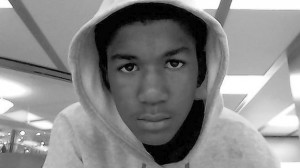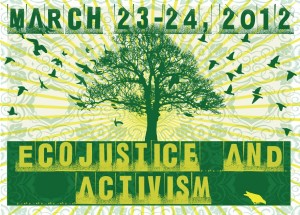A few months ago, I announced here on the site that an aspiring filmmaker in Ann Arbor, by the name of Emilia Javanica, was looking for actors to cast in a comedic horror film that she was making called the Red Blob Massacre. Well, the film has just completed production, and I took the opportunity to chat with Emilia about the experience of making a low-budget horror film in Ann Arbor. What’s follows is our exchange.
MARK: I’m curious, now that you’ve wrapped production, if you could reflect on the experience of shooting a movie here in Michigan, with next to no budget. Would I be right to assume that people were receptive to the idea, willing to volunteer their time, etc?
EMILIA: Yes! I have had amazing support from a great group of talented filmmakers, actors and artists, for a very limited amount of money. I did receive some funding through the UM School of Art & Design (Discretionary Grant & Smuckers-Wagstaff Grant), but it was definitely not enough to compensate everyone properly for all of the hard work they put into the project. I now understand why films can be multi-million dollar endeavors (although I’m not sure if I would ever want to go that route). The nice thing about low-budget filmmaking is that you have more control – if I had more sponsors, I would probably have to give them more, and live more up to their expectations. Who’s to say that some funder wouldn’t have insisted that the Red Blob be Blue instead? So, having full creative control is definitely a plus to low-budget filmmaking. In addition to the amazing crew of artists and filmmakers, I also had some really generous offers for locations to shoot at for free. One of them was at the house of my landlord, Steve Wild, who let us spend an entire 10-hour day shooting the home scenes for the film. Another was the Chair of the School of Art & Design, Brad Smith, who offered up his office for one of the killing scenes.
MARK: Was this your first foray into film making?
EMILIA: Yes. I’ve done a lot of shorter video work, but nothing quite so big. This is not a feature film – at this point it’s at about 20 minutes in length. But within that 20 minutes was SO much work!!! I’ve learned a lot from it. Really, about everything, not just filmmaking. I think I’m a better artist from it. It has been challenging – I’ve made some mistakes, and spent waaayyyyy too many hours editing in front of a computer. I’ve read a lot of books, watched a lot of instructional videos on Youtube, and gotten a lot of tips from friends with more experience. The week before we started shooting, I was kinda shitting bricks. I had no idea what to expect. But, luckily, I had a talented crew of filmmakers to work with who knew what they were doing. I couldn’t have done it without them.
MARK: If you were to do it all over again, what, if anything, would you do differently?
EMILIA: Good question! Well let’s see… I might have had even more people helping. Directing, making props, producing, acting in AND editing a film is a LOT of work. I really wasn’t sure what I was getting myself into – there were moments when I was like “Why the hell am I doing this??!” You know, those moments when I was up at 2:00 AM, wallpapering my entire bedroom with magazine cut-outs, while cooking a meal for a crew of 8, while trying to go over my acting and directing plans for the shoot call at 10:)) AM… that was pretty crazy. But… I also liked the craziness of it, the lack of sleep, the super productivity. For the most part, I was having a really awesome time doing it. So, yeah – I guess I might try and get a few more people to help next time, but, overall, I’m glad I did it, and, next time, I’ll certainly have developed skills to do it better. It’s a learning process.
MARK: Why horror? Do you have a love for the genre? Or, does it have more to do with the fact that there’s a built-in audience when it comes to horror, and a relatively low barrier of entry?
EMILIA: Both, actually. Honestly, I never was a big fan of horror in the past – I was the kid who had nightmares from Stand By Me. Horror makes me feel a little uneasy. But, when I was starting this project, I began watching all these B-movie horror films like The Blob, Swamp Women, Bride of the Monster, Attack of the Killer Tomatoes, Cat People, and just loved them. They were campy, but at times also disturbing and scary (well, Attack of the Killer Tomatoes wasn’t really scary, but you know what I mean..). Death has always been a topic of exploration in my artwork, so horror as a genre suddenly made so much sense, and had a lot of creative potential. Other films of inspiration included: Carrie, Eraserhead, Basket Case, Sins of the Fleshapoids, Little Otik, as well as classic silent horror films, particularly from the German Expressionist movement, such as The Cabinet of Dr. Caligari and Nosferatu. I saw the screening of Nosferatu accompanied by a live organ sound score at the Michigan Theater in October, and was blown away. This had a big influence on my decision to make my film a silent film, and have a live sound score performed to it at the screening.
Harry Shannon has a great quote in the article “Why We Write Horror” written by Michael McCarty: “For me, reading and writing horror is about eating my own shadow so it won’t eat me.” I totally relate to that – there are so many nightmares in my head, fears of premature death, and other horrible atrocities.. why not funnel them into something creative? Everyone has fears, or tendencies toward violence. Using them creatively seems like a pretty constructive way to process them.
The built-in audience for horror is definitely a plus. I think horror does have an easier entry-point than, say, a drama film about war and politics… People want to be entertained, and horror is entertaining. At times you want to look away, but your eyes are glued to the screen. Combining humor with horror makes the entry point a little easier, and opens people up more to issues that they might be closed off to in another context. It’s actually a really good medium to talk about deeper issues. Even though this event should (hopefully) be fun and crazy, and the framework of the film is pretty absurd, I hope it will also create dialogue and leave people thinking about the underlying issues of the film beyond the night of the event.
MARK: As someone who has thought of shooting a film locally, I was wondering what advice you might have.
EMILIA: Find a good team of people to work with. Who you work with really makes the film. You want it to be fun! Shooting the film was a lot of work, but we laughed a lot too. That really alleviated the stress for me. It was an adventure!
Also along those lines – if you’re cooking for people to save money (which I did), get a crock pot. That was one of those really great purchases I made right before the filming that helped a lot. All I had to do was throw in the ingredients the night before and wallah – in the morning it was ready to serve.
Don’t rely on Michigan winter. The script of my film had a lot of snow in it. When January came around to shoot, there was still hardly any snow on the ground! We lucked out that we did get one lovely snowy day when we were able to shoot all of the snow shots outside, but, in general, be prepared for weird weather to throw a curve ball at you.
Make a storyboard. I wrote the script, but that wasn’t going to help on the set. At first I was hesitant to draw out an entire storyboard because my drawing skills aren’t perfect, and it seemed like a lot of work. But I did it, and am so glad that I did. It gave a structure that we could plan our shooting schedule around, and served as a good jumping off point. Which doesn’t mean that we didn’t improvise and add/subtract shots as we went along, but we always had something to fall back on. Drawing the storyboard also really helped me out with visualizing the world of the film, including the drawn elements and stop motion animation.
MARK: When will the film debut? And what can those of us who come out for it expect? I’m not mistaken, there’s more to this that just the film, right?
EMILIA: Yes! The film will debut on Thursday, April 5 & Friday, April 6 at the Cavern Club (210 S. 1st Street, Ann Arbor, MI). The doors will open at 7:00 PM, and the screening will start at 8:00 PM sharp. In addition to the screening, there will also be a live performance. The Cavern Club is an amazing space, and those who come out can expect to interact with performers, and be a part of the event. It will be a full experience. I’ve always been into engaging my audience in more ways than just having them sit as passive onlookers. There will be various ways to interact within the space, and the last scene of the film will actually be filmed on location at the event. So people can expect to be a part of that in some way. It will be fun!!! Tell people to dress up and wear their dancing shoes! If they’re over 21, there will be drinks available for purchase at the bar. Popcorn and other treats will be provided. DJ tunes will be played by Chuck Sipperley. And the actual film will be screened to a live sound score played by Simon Alexander-Adams. So yes, there will be lots more happening than just the film.
MARK: Having made one film, are you likely to make more? Or, was this just a one-time thing, done in order to fulfill a University requirement? And, if you are planning to do this again, have you given any thought as to what the subject matter might be?
EMILIA: I would love to make another film, and definitely don’t see this as just a one-time thing/University requirement that I had to fill and then be done with. I’d wanted to make a film for a long time, act. I don’t have any specific ideas for the next project, but horror is something that still is on the top of the list. Horror combined with humor, that is. I did have one idea to do a short film set in the laundry room in the basement of my house – I always feel creeped out when I go down there. But no set plans yet. After the premiere of Red Blob Massacre, I’ll actually need to go back to the editing room and add in the final scene, which will be filmed at the event. That, and work on recording the live sound score to add into the film. Once that’s done, I’d like to submit the film to film festivals. I’m also considering the possibility of trying to take the film, combined with live performance, on tour to a few other places – Detroit, Chicago, Minneapolis, New York… that would be awesome. So we’ll see how it all unfolds.
MARK: Given your prolonged exposure to this team of local film people that you assembled for the film, do you feel as tough you have a pretty good handle on the local indie film scene? Would you say that we have a cohesive and growing film community here?
EMILIA: It does seem like there are a lot of filmmakers in the area, and I’ve been introduced to a lot of new people involved with the scene through this project. And then there’s the Ann Arbor Film Festival, which is a nice blend of local and international filmmakers and film lovers. I definitely think it’s out there, but, to be honest, I’ve been so immersed in my own project that I haven’t really had the chance to get too involved with the scene as of yet, except for the people I’ve worked with. This is certainly something on my list of things to do. I think this project is definitely a good way to break into it. I’m ready to work on the next project for sure – either making another of my own film, or being a part of someone else’s!
MARK: What’s the biggest mistake that you made, and what did you learn from it, if anything?
EMILIA: Biggest mistake: hmmmmmm…. it’s been a pretty big project. I might have toned it down a bit… but, then again, I always do that. The live performance part has been challenging to coordinate a bit – it’s always difficult to find an ending to something. But it’s coming together. Honestly I don’t think anything has been a tremendous mistake, just small things that I’ll learn from and do better the next time!
MARK: Is there anything that I should have asked and didn’t?
EMILIA: Something else you should have asked: What’s my sign? It’s capricorn. What’s my favorite desert? Ginger cookies. What’s my dog’s name? Jay Jay. Was Jay Jay part of the film? Yes, he was there for a lot of the filming, mainly the stuff we shot at my house. Everyone on the crew was passing him around so he wouldn’t bark when we were shooting (he’s a chihuahua, so he’s easy to hold). Having a dog on the set is nice. Just make sure you have someone to hold him at certain points. When we shot the nightmare scene, he kept wanting to get up on the bed and curl up by my legs, which was super sweet, but didn’t really fit in with the story…
MARK: What books did you read for inspiration? Did you take film classes? I’m just curious if, for instance, you read any of John Waters’ books on the making of his early films, watched any of those little videos by Robert Rodriquez on making movies tricks, etc. And, if so, what did you find the most useful and/or inspiring?
EMILIA: Yes- I did watch a John Waters interview, as well as a David Lynch interview about his experience making Eraserhead, along with several other random interviews and instructional videos. Most helpful books I read: “Digital Filmmaking 101: An Essential Guide to Producing Low-Budget Movies
” by Dale Newton & John Gaspard, along with “Fast, Cheap, and Under Control: Lessons from the Greatest Low-Budget Movies of All Time
” by John Gaspard. The first book was helpful for the nuts & bolts of filmmaking, the second for inspiration. There’s also some great interviews with George Kuchard on youtube, here’s a link to one of my faves – some good inspiration for super low-budget underground filmmaking. There were a ton of other random filmmaking tips I discovered on the internet, but at this point I’m not sure where all those links are.
In retrospect, I probably should have asked more about the plot of the film. If I were a better blogger, that’s what I would have done. As I’m totally selfish, though, I went off on a tangent about the process, which I find incredibly interesting. Sorry about that, but I have an idea for a short film involving me and puppet Mark that I really need to get started on.

 By now, you’ve probably heard about Trayvon Martin, the 17 year old who was recently shot to death in a gated Florida community by an armed, criminally-overzealous-at-best member of a neighborhood watch group. Martin, who was black, was making his way back to his father’s home, after having purchased some candy and an iced tea from a nearby 7-Eleven, when he attracted the attention of 28 year old George Zimmerman. Zimmerman, who informed a police operator that the young black man was wearing a hoodie, and looked out of place, took it upon himself to pursue the young man. Zimmerman was told not to do so by the police dispatcher, but proceeded to anyway, saying, “They always get away.” According to initial police reports, a confrontation ensued, during which Martin was killed. Zimmerman, it seemed, had acted in self-defense.
By now, you’ve probably heard about Trayvon Martin, the 17 year old who was recently shot to death in a gated Florida community by an armed, criminally-overzealous-at-best member of a neighborhood watch group. Martin, who was black, was making his way back to his father’s home, after having purchased some candy and an iced tea from a nearby 7-Eleven, when he attracted the attention of 28 year old George Zimmerman. Zimmerman, who informed a police operator that the young black man was wearing a hoodie, and looked out of place, took it upon himself to pursue the young man. Zimmerman was told not to do so by the police dispatcher, but proceeded to anyway, saying, “They always get away.” According to initial police reports, a confrontation ensued, during which Martin was killed. Zimmerman, it seemed, had acted in self-defense.  “ECOJUSTICE AND ACTIVISM”
“ECOJUSTICE AND ACTIVISM”









